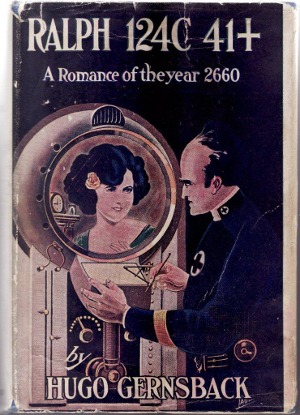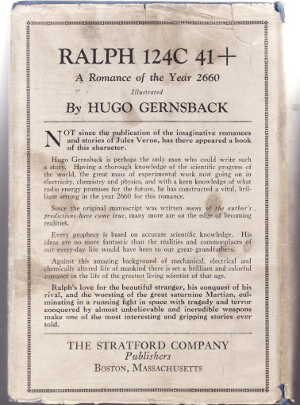 Yesterday I received an email from one of our contributors who shall remain nameless and locationless, at least for the time being. The reason(s) should be obvious in just a few short paragraphs.
Yesterday I received an email from one of our contributors who shall remain nameless and locationless, at least for the time being. The reason(s) should be obvious in just a few short paragraphs.
But first, a small overland foray into the history of the SF genre. More specifically, a bit of history devoted to the Father of Science Fiction – Hugo Gernsback – he of the grand ideas: technophile, publisher, visionary. He who founded the Scientifiction Genre (and he who was unfortunately well-known for late or no payments to authors.)
As has been recounted before, Hugo believed in science and technology. He particularly believed that a nation schooled in science, enthusiastic about science and engaged with it on a daily basis would bring about a glorious future for all of humankind.
As articulated in his opening editorial in Amazing Stories Volume 1, Number 1 (April, 1926, for those of you not really paying attention) he believed that scientifiction (try to say THAT ten times fast…) he believed that science fiction stories should educate, speculate and inform. Later, he would remark that science fiction was “candy-coating for science”.
Science Fiction was so new that it had taken ‘Uncle Hugo’ a few years to develop the concept and test it out. To that end he sat down and wrote the kind of thing he was looking for and began running it in his gadget magazine – Modern Electrics – in April of 1911. (I’ve often wondered if the first issue of Amazing wasn’t published with an April cover date as partial homage to Ralph.) Stories of Ralph and the future of modern technology would last for 11 installments and were eventually combined into the novel being discussed here.
Later, Modern Electrics would give way to The Electrical Experimenter, which would change its title and become Science and Invention. That magazine continued Hugo’s tradition of including fiction that was illustrative of the kinds of future technological advances made possible by today’s (1920s) technologies. In fact, Hugo devoted several issues of that magazine to special “Scientific Fiction Number” issues, which were in actuality tests to gauge reader response to a planned magazine devoted entirely to such fiction. Needless to say, response was good.
On the other hand, Ralph itself wasn’t so good. Execrable is the word most often associated with its reviews. On the other hand, It is considered to be the very first example of ‘modern’ american science fiction and it was just jock-full of predicted technologies – many of which actually came to fruition. (In fact, Ralph 124C41+ is a perfect example of the intentional “prediction” of future technologies, so take that those of you who believe there’s no prediction in SF – though that is a discussion for another time.) Hugo forecasted (a word he used as the title for his annual missives btw).
 A few of the “predictions” (fairly accurately portrayed) include: television, synthetic milk, synthetic foods, videophones, space flight, transcontinental airlines and radar. (Hugo would own one of the first broadcast television stations in the US.)
A few of the “predictions” (fairly accurately portrayed) include: television, synthetic milk, synthetic foods, videophones, space flight, transcontinental airlines and radar. (Hugo would own one of the first broadcast television stations in the US.)
If any of this sounds familiar, some of you may recall that our genre is currently wrestling with the issues of improved literary techniques in our fiction….nothing changes so much as it remains the same….
Anyway, to put this to bed: Ralph 124C41+’s fame lies more with its place in the literary pantheon of the genre as the first “modern” SF novel. Numerous editions were published over the years (I’ve got an early paperback copy from a UK publisher). The most desirable copy of this book however is its first edition, published by Stratford Company in 1925.
Our nameless friend recounts that about forty years ago a friend who owned a used bookstore called him in to look at something interesting he’d acquired. To our friend’s astonishment, it was a copy of the first edition of Ralph 124C41+, complete with dust jack, in really good condition.
To add to the astonishment, this particular copy of the book was signed “Sincerely Yours, Hugo Gernsback”.
 But the real kicker to this tale is this: our friend acquired that copy for $2.75. ” (yes, the decimal point is in the right spot)”.
But the real kicker to this tale is this: our friend acquired that copy for $2.75. ” (yes, the decimal point is in the right spot)”.
Research for a signed first edition of this book has turned up an approximate value of $9,500.00. ” (yes, the decimal point is in the right spot)”
It will soon be going up on the auction block to help pay for more mundane things – a new bathroom (I don’t recall Ralph ever devoting any of his energies to plumbing…), a new heating system, etc. – such are the vicissitudes of life. On the other hand, looks like Hugo and Ralph are kind of the gift that keeps on giving….
And now you know why our friend must remain nameless and locationless.
(A formal write-up of the acquisition and sale of this piece of Scientifictional history will be published in Amazing shortly after the completion of the book’s sale.)










